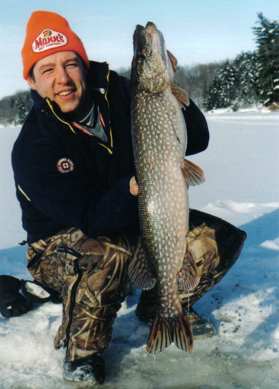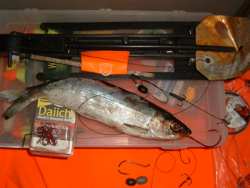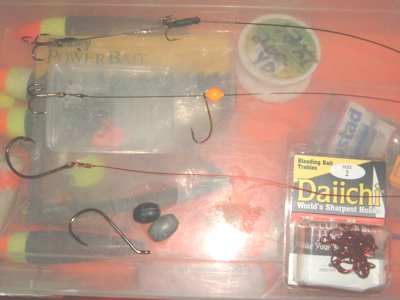| In this issue:
Our
Fishing
Video Site is up and running. If you have hi-speed
internet access
click
here to see some great short fishing video clips. We've
added a few new UNDERWATER Videos
Averys Tackle - Home of the Jumla
Sunny Side Lodge
- We are located on the north shore of
beautiful Lake Nosbonsing. We have 5 fully equipped lake front
housekeeping cabins. There is a wide variety of fish in Lake
Nosbonsing, walleye, northern pike, trophy muskie, small and
largemouth bass and yellow perch. We also offer a full guided black
bear hunt in the fall which includes baited trees stands and
accommodations for a 6 day hunt (license is extra) there are also
fall and winter fishing packages available
Golden Eagle Camp - Great fishing for
Northern Pike, Walleye, Smallmouth Bass and other pan fish in the
famous Montreal River system. We’re surrounded by many remote lakes
to plan your daily fishing adventures. Complete packages available
with meal plan, boat & motor, all equipment, bait and ice included.
Plan this year’s vacation with us for fishing, bear hunting,
moose hunting and great snowmobiling!
Kenda Wilderness Lodge - Located on
Mesomikenda (Beaver) Lake, near Gogama. Kenda is a small informal
camp designed for your comfort. Fish for 30 miles on a beautiful
chain of lakes without a portage, or if you wish to portage we have
several lakes within walking distance that we maintain with boats
and motors. The log cabins are built of peeled log. The cottages are
insulated and paneled. We offer bear and moose
hunting, and fishing for walleye, pike, rainbow, speckled (brook)
and lake trout.
Cedar Ridge Lodge - At our Lodge you
get a truly memorable experience at a reasonable cost. Run by
sportsman who have a passion for the outdoors and want you to
experience the same. Located on pristine Burt Lake, 30 km west of
Kirkland Lake. Surround yourself with thousands of acres of crown
land and an abundance of your favorite hunting or fishing species,
including: Moose, Bear, Wolf, Grouse, Ducks, Geese,
Trout, Pike, Walleye, Small Mouth Bass and more! We operate a clean
lodge and offer full American Plans.
|
Go on the Deadbait Diet for Trophy Pike!
By J.P. Bushey
 Most people’s New Year’s Resolution is losing twenty pounds. Once
the ice is safe and the season opens, I’m normally out on the big
bays and shoals trying to gain twenty pounds. Twenty pound-plus
pike, that is. Early January produces more pike over 42 inches for
me than all other months of the year combined. And I catch the
majority of them fishing deadbait under tip-ups. If I was forced to
fish one technique at any one single time of the year for a magnum
pike, I’d leave the long rods and tackle boxes in the shed and the
boat on the trailer. I’d be out there getting my hands smelly in
January fishing ‘stiffs.’ Most people’s New Year’s Resolution is losing twenty pounds. Once
the ice is safe and the season opens, I’m normally out on the big
bays and shoals trying to gain twenty pounds. Twenty pound-plus
pike, that is. Early January produces more pike over 42 inches for
me than all other months of the year combined. And I catch the
majority of them fishing deadbait under tip-ups. If I was forced to
fish one technique at any one single time of the year for a magnum
pike, I’d leave the long rods and tackle boxes in the shed and the
boat on the trailer. I’d be out there getting my hands smelly in
January fishing ‘stiffs.’
Early ice is an extension of the late - fall / freeze - up feeding period
for pike (my second choice for a giant is late, late fall for this
reason). Fish are still moving, and when you’re tip-up fishing,
traveling fish are the biters. Pike move a lot under the ice, more
than people realize. Tip-up fishing is a lot more predictable and
productive in areas where different fish filter through during the
day. This could be a mile-long breakline rimming the edge of a bay,
or a small access point leading into or out of deep water to a
feeding station. (Many fishermen refer to this type of spot as a
funnel). Just like walleye, laker or perch fishing, be prepared to
cut a lot of holes and remember that if the fish are traveling, so
should you. Move around on a specific spot, or check different spots
on the lake if you’re using at ATV on snowmachine. Know where you’re
going and the ice conditions before hand. First-ice is when the
majority of accidents occur, and they are 100% avoidable with care.
When in doubt, don’t go.
From lake to lake, you’ll need good knowledge of what baitfish are
legal for bait. Only a mile or two between water bodies can make a
dramatic difference on what you can or can’t fish with! Smelt, perch
and lake herring are all excellent for deadbaiting big pike, but
they all have places where they can’t be used, by law. A call during
business hours to the local MNR detachment is the most direct and
fool-proof way to avoid having your day ruined.
 When
I can legally use them, lake herring (ciscoes) and smelts are my
favorites for big pike. They’ll leave an oil slick in your hole when
you drop them down. They’re a high-scent presentation, which I’ve
always felt is crucial in the dark water under the ice and snow.
Pike have excellent olfactory receptors. Deadbaits with that oily,
fishy stink are deadly, and usually the magic ingredient for a
trophy lake. Smelts and ciscoes soften up a lot once they’ve been
soaked, but continue milking out a heavy scent trail. Suckers, chubs
and perch have tougher skin, and seem to hold together better, but
don’t match the scent content of the open-water baitfish. Whichever
bait you’re using, bring a lot, and change it up every couple hours.
Re-freeze leftover deadbait. Coarse salt adds additional scent and
it also toughens the bait’s exterior. The trophy pike waters I fish
also have lakers, and heavily salted tubes and twisters catch more
trout than plain ones. It makes a difference. When
I can legally use them, lake herring (ciscoes) and smelts are my
favorites for big pike. They’ll leave an oil slick in your hole when
you drop them down. They’re a high-scent presentation, which I’ve
always felt is crucial in the dark water under the ice and snow.
Pike have excellent olfactory receptors. Deadbaits with that oily,
fishy stink are deadly, and usually the magic ingredient for a
trophy lake. Smelts and ciscoes soften up a lot once they’ve been
soaked, but continue milking out a heavy scent trail. Suckers, chubs
and perch have tougher skin, and seem to hold together better, but
don’t match the scent content of the open-water baitfish. Whichever
bait you’re using, bring a lot, and change it up every couple hours.
Re-freeze leftover deadbait. Coarse salt adds additional scent and
it also toughens the bait’s exterior. The trophy pike waters I fish
also have lakers, and heavily salted tubes and twisters catch more
trout than plain ones. It makes a difference.
If your baitshop sells suckers and chubs, try to get the owner to
set them aside for you. June, July and August are the toughest
months for dealers to keep minnows (especially the larger ones)
alive, and you can load up for winter deadbaiting with ‘tank kills’
at this time. Spring runs of suckers happen in several urban ditches
and creeks too. You can get a year’s worth of bait with a few worms
and a spinning rod. While they’re moist, layer them with salt in
air-tight plastic bags, and freeze. Eight per pack is ideal for a
day’s fishing, and it doesn’t crowd them. Label each bag, ‘Eight
Inch Chubs,’ or ‘Twelve Inch Suckers’ and take a variety when you
fish. Some days, pike will only take smelts. Other days, suckers or
chubs get bit. A preference emerges more often than not.

For baits less than eight inches, one hook will work. You can use a
treble or a single hook. Circle hooks are getting popular with pike
fishermen who deadbait under floats in the spring as a live-release
option. Just be aware that they require a real sense of timing, and
you can gut-hook a pike easily with one.
No matter what style of hook you use, make sure the bait hangs
perfectly horizontal, and always err on the side of setting on the
fish too early rather than too late. For the smaller chubs, smelts
and suckers, I use 1/0 or 2/0 Eagle Claw trebles and hook pike in
the corner of the mouth of the roof nine out of ten times, and I hit
them on the run all the time. Steady pressure is all it takes to
sink a circle hook, there is no hook-set whatsoever. A couple
smooth, hand over hand pulls will sink a treble every time. There’s
no better feeling in the world than locking down on a line that’s
ripping out, only to feel a forklift on the other end.
The big baits are best fished on tandem-hooked rigs, normally with
one hook set in the back, and the other near the head. Clear this up
with the MNR also. Ontario has very specific laws that define
‘lures’ based on the number of hook points they have. You might need
to add a small spinner blade or twister tail you your wire harness,
making it a ‘lure’ to be in compliance. Neither will do anything but
enhance your rig, so that’s a good thing. I routinely use suckers
and ciscoes over one pound, and have not found a pike big enough to
shy away from them. Baits from fifteen to twenty inches are true
giant killers, and first-ice is the time to show them around under
the ice. I’m lucky to have a couple of excellent, year-round ciscoe
fisheries that allow me to stock up on bait with a light spinning
rod while working on my tan. They’re great sport in themselves.
Pike over the twenty pound mark can be landed and released easily
using a set of 3/0 treble hooks or a 3/0 treble and 5/0 egg hook
combination. Eagle Claw and Gamagatsu make some excellent hooks.
They’re stiff, but also very sharp. With tandem hook rigs and
oversized deadbait, you still don’t need big, clumsy hooks and
rigging. Rig your bait to breakaway when you hit the fish by
knicking it as lightly as you can before sending it down the hole.
Every season I’m amazed at how well this type of set-up hooks and
hold pike in the mouth for a good release. Most of the time, one of
the hooks will get the pike and the other will be flopping around
freely. I make all my own rigs with ninety pound coated wire and
shrink tubing. Be extra careful hand-landing big fish with tandem
hook rigs.
Wind-activated tip-ups add a new dimension to deadbaiting, adding
motion to an already natural-looking and smelling package. HT’s
Windlass is the original, and still unbeatable after a lot of years
on the market. I fish with heavy Dacron and braided line from 36 to
80 pound test, and do all sorts of things to the unit to maximize
its effectiveness. I bend and cup the fin and add extra metal to it
to catch more wind. I weight the arms offset the weight of heavy,
semi-frozen baits. Other tip-up styles and rigging all work as well.
The Windlass is at its best when the holes aren’t freezing up too
bad and when there’s a good breeze to work with. Frozen meat floats.
I weight small baits with a nail or piece of coathanger wire,
inserted into the vent, lengthwise. A pegged egg sinker from ¼ to 1
ounce butted up against the leader’s swivel gives good balance,
especially when setting a wind tip-up’s arm from above. Pre-soaking
large baits in water or inside a baggie in your breast pocket will
make them sink slowly and hang properly. I store my wire harnesses
on a chunk of foam. Just wrap them around and seal them in a plastic
bag. A big fish will normally kink the wire, so carrying a good
selection is a good idea.
I rank pike over twenty pounds every bit as highly as I do muskies
over fifty inches. In my opinion, trophy pike are rarer and tougher
to catch. Deadbaiting is a top technique for these special trophies.
Handle the fish carefully, and always set the hook sooner than
later. Big pike won’t toy around with a bait. They’ll blast it, and
peel out the line hard and fast. There’s no need to wait. The bigger
the fish, the more catastrophic their strike and initial run away
from the hole. And don’t think for a minute that deadbaiting is only
for trophy pike. I’ve caught walleyes over eight pounds and some big
lake trout on stiffs, under tip-ups. This is always a welcome
surprise. Use stout tackle, get a picture and let that fish go back.
It’s amazing how quickly you can gain and drop twenty pounds in the
New Year when you’re deadbaiting.
|